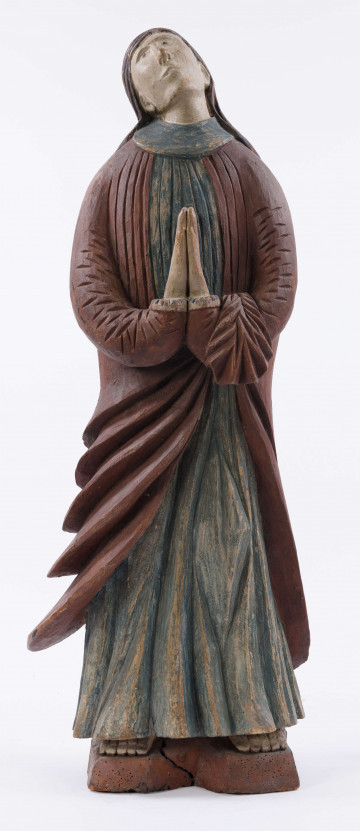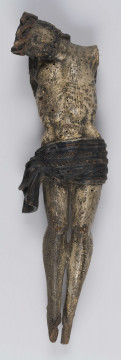
Saint John of Nepomuk
1790 — 1810
National Museum in Lublin
Part of the collection: Folk Art of the Lublin Region (17th–1st half of the 20th c.)
Roadside chapels of various design, scattered in the Lublin region and throughout the country, are the work of carpenters and folk carpenters. The figures in them are often the work of anonymous sculptors, who looked for inspiration in churches, modelled on Gothic, Baroque and Rococo representations. Although most of the sculptures were based on traditional iconographic patterns and were copies of miraculous images, they expressed the diversity of talent and individuality of the artists. A significant part of them was characterised by naturalism, simplification and geometrisation of shapes (for example, inclination of the head meant sadness, and parallel grooves were supposed to reflect wavy hair or robes), static character and predominance of stillness over movement, frontal arrangement, rhythmicity of individual elements, deformation of body proportions, synthetic treatment of solids and striving for reduction of elements resulting from economy of material.
Sculpture material was most often wood, occasionally stone and clay. The choice of material or type of wood depended on the type and size of the sculpture, the wealth of the founder and the availability of material in the area. Over-metre-high figures placed on pillars or in house or brogue chapels, exposed to sun, rain and wind, were carved in the hardest oak. Small sculptures for roofed chapels or domestic altars were made of soft lime wood or other deciduous wood without knots - poplar, alder or pear. Simple tools were used for working: knives, hatchets, axes or chisels, ordered from local blacksmiths. The works were often covered with polychrome in imitation of church models. Oil technique and traditional colours were used. Faces were painted in light shades of pink with brown undertones. Hair and beard were usually in dark colours. Mary's dresses, cloak and veil were painted in red, white and blue, Christ's hip perisonium was usually white, and the colours of the saints' clothes tried to reproduce the colours of paintings and authentic habits.
Author / creator
Dimensions
cały obiekt: height: 16 cm, width: 36,5 cm
Object type
sculpture
Technique
polychromy
Material
wood, paint
Creation time / dating
Creation / finding place
Owner
The National Museum in Lublin
Identification number
Location / status

1790 — 1810
National Museum in Lublin

1880 — 1900
National Museum in Lublin

1801 — 1900
National Museum in Lublin
DISCOVER this TOPIC
Castle Museum in Łańcut
DISCOVER this PATH
Educational path